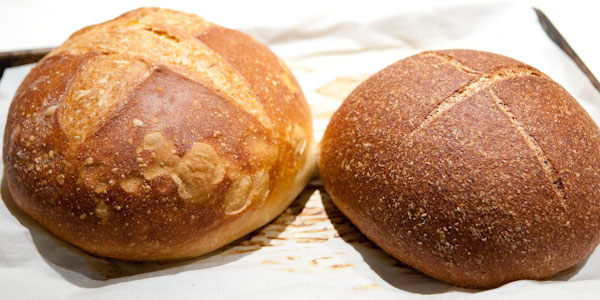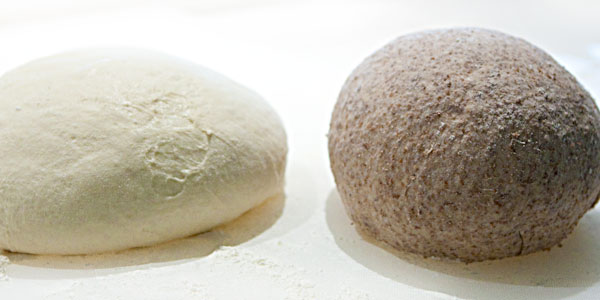
I need to read up more on this, but it appears that wheat flour doesn’t rise like white flour. I just ran a test to see the difference between using a standard white flour and whole wheat flour to make bread. I ran the test according to how I normally make my rustic white bread.

I used the same weight of flour and water for each. The structure of the wheat ball was much firmer. I kept the rise time the same for both, to keep the test on a level playing field. My conclusion? That I don’t have any idea what I am doing. Actually, I think I would not use 100% whole wheat flour. A mix would work better. And, a longer proof time.
Nice loave you got there…
I know whole wheat flour is “good for you,” but I have never liked baking with it exclusively–loaves and baked goods always seem far too dense; I prefer mixing flours to lighten things up a little. However, the King Arthur White Whole Wheat is another story. It has all the goodness of whole wheat (because it is), but none of the downside. The white whole wheat dough behaves much like the white flour dough when making bread. When cooked the color is a little more tan than white, and the texture is a bit hardier, but still more refined than if using typical whote wheat flour alone.
It’s 2 different flour, they cannot be compared.
You cannot definetly work them in the same way. The result will always be different.
If you’re looking for Rustic traditional white bread you need “Fermentation” like Poolish, like Levain (sourdough in english)
It’s pretty much technical.
Even for the wheat flour it’s different.
Speed mix, rest, shape, steam, cut, bake, etc…..everything is different !
I know it’s not helping you but school and practice are the only way to understand all the process.
Bonne Chance !
Yes, most good recipes for wheat bread call for half wheat and half white. I’ve never seen a very good, successful recipe with all wheat! It’s just too heavy, dense and wet to make good bread.
I have been substituting Richardson Farm’s whole wheat flour for most of the white flour in my standard bread recipe, and THIS EXPLAINS why my loaves are not rising as high as I like them to, even though I am letting them rise for twice as long. Hmmmm. I am going to have to play around with my ratios, I can see!
I am using Richardson Farm’s flour also. But, I think that it may have more to do with the grind than the supplier. I think I am going to try a 50/50 ration.
Thanks for doing this experiment. As a newbie baker, I was thinking that I was doing something wrong, as my wheat loaves did not rise as much, and were dense and heavy. It was recommended that I use wheat pastry flour, as it is not ‘gritty’ and a mix of it and white seems to work great. Great comments and advice also.
Thanks. Who would know that three ingredients could be so complicated?
For a rustic bread, I would only substitute less than half the total flour with whole wheat flour and expect a denser bread with even more chew than your all white flour loaf. For me, the earthiness of whole wheat flour needs additional ingredients to highlight/contrast its flavor, so I don’t care for it much as a plain flour-salt-water-yeast rustic bread. If you’re after a rustic bread that uses whole wheat flour, however, I’d recommend looking at Peter Reinhart’s Bread Baker’s Apprentice and Rose Levy Beranbaum’s Bread Bible for help. Baking with whole wheat does require a different technique and the books are better teachers than plain old trial and error, IMO.
When it comes to the rise or lack thereof when using whole wheat flour, one explanation I read in one of those bread books was that the bran in whole wheat flour has sharp edges that create micro-cuts in the gluten that weaken it. Strong gluten = strong rise.
I’ve had the best success adding vital wheat gluten. It helps whole wheat doughs rise more like white flour doughs. It’s the only way you’ll achieve an edible 100% whole wheat sandwich loaf and it would probably help quite a bit with a rustic loaf, though I’ve never tried it.
For a soft sandwich loaf, one loaf I love uses all three: white all-purpose flour, whole wheat flour, and vital wheat gluten. It makes a tender, sweet, and pretty healthy sandwich loaf. Recipe below so you can get an idea of the ratios (credit goes to Mags at http://othersideof50.blogspot.com/).
Oatmeal Bread
1 1/4 cups boiling water
3/4 cup old-fashioned rolled oats
1/4 cup wheat bran
2 TBSP unsalted butter
1 1/2 tsp salt
1/4 cup honey
1 cup whole wheat flour
1 1/2 cups unbleached all-purpose flour
2 TBSP wheat gluten
1/4 cup nonfat dry milk
2 tsp instant yeast
Place oats, wheat bran, butter, salt and honey in a medium mixing bowl. Pour boiling water over and stir well to combine. Let mixture cool to lukewarm (around 100 degrees)
In large mixing bowl whisk together the flours, wheat gluten, dry milk and yeast. Add oat mixture and stir well to combine. Let mixture rest for 15 minutes.
I kneaded the dough with my Kitchen-Aid mixture and dough hook for about 7 minutes. If you’re kneading by hand, turn dough onto lightly floured surface and knead for 8-10 minutes, until you’ve made a soft, slightly tacky dough. Place the dough into a lightly greased bowl, cover and let rise for about 1 hour, or until doubled in size.
Spray a 9X5 bread pan with cooking spray. Lightly grease hands and deflate dough. Turn dough onto lightly greased countertop and shape into a log. Place into prepared pan. Spray plastic wrap with cooking spray and loosely cover loaf. Let rise until it has risen at least an inch over the rim of the pan, 60-90 minutes.
Preheat oven to 350 degrees.
Bake bread for about 45 minutes, tenting with foil for the last ten minutes to prevent over-browning. Remove from oven and turn onto a cooling rack. Let cook completely before slicing.
Whole wheat flour needs more water/liquid as the bran really absorbs a lot of liquid. That is why your wheat bread was so much firmer. A great book on whole grain baking is by Peter Reinhart. He has many entirely whole grain recipes that are light and moist. Perhaps your local library will have a copy.
Came across an amazing i phone/pod app. It’s an easy to follow video tutorial on how to make flat breads. The breads look amazing, and after l finished making them l was very impressed!! Can hardly wait for her next video to come out. Here is the link for the app. http://dailyappshow.com/cooking-with-eat-drink-talk-lighter-than-air-flatbreads and check out her website Eat Drink Talk, for free over the top recipes!
I’ll check it out, thanks.
Marcella is right: whole grain flour of any kind needs (ca. 10 percent) more water than regular white flour. there are other reasons why the whole wheat loaf doesn’t rise that well and is denser: first, the gluten content in your whole wheat bread is lower than in a white flour bread, thus it’s harder to form an elastic bread dough that holds the gases that the yeast develops. and second whole wheat flour is very often ground coarser than white flour – same result as mentioned before.
hey !
can you help me to find out what conditions wheat flour have to follow??? do u have any idea where i can look that. i need warehousing conditions for wheat flour for a bread company.
thanks so much
i appreciate your help
I like the layout of your blog and I’m going to do the same thing for mine. Do you have any tips? Please PM ME on yahoo @ AmandaLovesYou702